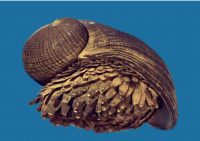In 2013, a fireball exploded over Chelyabinsk, Russia, leaving a very rare meteorite on the earth. The difference between this meteorite and other similar meteorites is that it has dark veins. This formation process is called “shock darkening”. change”. However, planetary scientists have not been able to determine what type of asteroid these particular meteorites originated from.
Recently, researchers from the University of Arizona published a paper in the “Journal of Planetary Science” saying that they have discovered an asteroid named 1998 OR2, which may be the source of the impact darkening meteorite. The near-Earth asteroid is about 2.4 kilometers in diameter and passed by Earth at close range in April 2020. Meteorites are fragments of asteroids that collided with Earth.
“Shock dimming is the process of changing the temperature of a planetary body, partially or completely, when an object hits a planetary body with enough force,” said Adam Battle, lead author of the study and a graduate student in planetary science at the University of Arizona. Melting planetary rocks, changing their appearance in human visual observations and data records, shock darkening has been found in meteorite samples, but they only come from a small number of meteorite samples from the asteroid belt of the solar system, which is located on Mars and Jupiter between.”
Vishnu Reddy, a professor of planetary science and Barthes consultant who discovered the asteroid belt shock dimming in 2013-2014, worked with engineering professor Roberto Falfaro. Furfaro) co-heads the Lunar and Planetary Laboratory’s Space Domain Awareness Laboratory, where Barthes has been working since 2019.
The researchers found evidence of a shock-darkening process in the meteorite. The researchers found evidence of a shock-darkening process in the meteorite.
Reddy pointed out that meteorite collisions are common in asteroids and any solid matter in the solar system, because we can see the corresponding impact craters in spacecraft observation images, but it is found that the meteorite-derived celestial bodies that produce the effects of collisional melting and shock darkening are very rare. It is rare to find a near-Earth asteroid dominated by this process, which has important implications for collision risk assessment. Barth’s findings suggest that in our classification tools, ordinary chondrite asteroids could appear carbonaceous if subject to shock darkening, and the two materials have different physical strengths, which is a major challenge in trying to make dangerous Very important when the asteroid is off course.
Using the Raptor (RAPTORS) telescope on the roof of the Kuiper Space Science Building within the Institute, Barthes, Reddy and colleagues collected data on the surface composition of the 1998 OR2 asteroid and determined that it looked like an ordinary chondrite asteroid. Chondrite asteroids have a lighter appearance and contain olivine and pyroxene minerals.
However, when the team ran the data through a classification tool, it turned out that the asteroid was a carbonaceous asteroid, a typically dark and relatively featureless asteroid.




GIPHY App Key not set. Please check settings